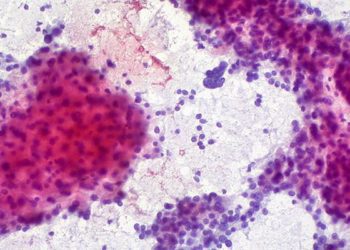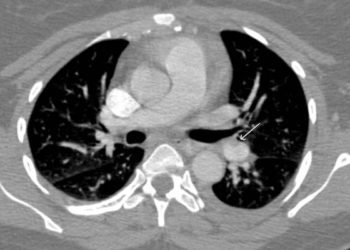Hepatic arterial phase imaging more sensitive than portal venous phase in the detection of hepatic lesions and arterioportal shunting [Classics Series]
This study summary is an excerpt from the book 2 Minute Medicine’s The Classics in Medicine: Summaries of the Landmark Trials
1. Hepatic arterial phase imaging detected more hepatic lesions than portal venous phase (PVP) imaging, as well as arterioportal shunting not seen on PVP images.
2. PVP imaging was more sensitive in the detection of portal vein thrombosis due to hepatic tumor invasion.
Original Date of Publication: May 1996
Study Rundown: The administration of contrast has improved the imaging of malignant liver lesions using computed tomography (CT). Some tumors, however, are more difficult to visualize despite the use of contrast, including primary hepatocellular carcinoma (HCC), metastases from renal cell carcinoma, pancreatic islet cell tumors and breast carcinoma. This can be explained by the increased vascularity of these lesions, which allows for rapid enhancement and attenuation, similar to background liver parenchyma. In recognizing that the visualization of morphologic CT contrast patterns is largely influenced by techniques of contrast administration, Freeny and colleagues found that benign hepatic hemangiomas could be differentiated from malignant hepatic neoplasms using bolus dynamic scanning. In a later study, Heiken and colleagues established that CT imaging of hepatic tumors could be further improved by performing CT during arterial portography (CTAP) via the superior mesenteric or splenic arteries. This technique allowed for the enhancement of the portal vein and intrahepatic vessels, which proved to be useful in predicting tumor behavior when Matsui and colleagues observed that intranodular portal blood flow decreased with increasing tumor grade. The same study also found that hepatic angiography could be used to identify HCCs as the arterial blood flow to these lesions exceeds that of the surrounding liver. As such, these lesions can be seen early during contrast administration through the aorta or hepatic artery, otherwise known as the hepatic arterial-dominant phase (HAP) of contrast delivery. In the study conducted by Baron and colleagues, hepatic arterial-dominant phase (HAP) imaging was compared to portal venous-dominant phase (PVP) imaging in the evaluation of HCC. The results of this study showed that considerably more lesions were detected during HAP than PVP, including lesions not seen with PVP imaging. HAP imaging was also able to identify arterioportal shunting, which was not evident in any of the images produced during PVP. Both techniques were able to identify portal venous thrombosis, however, some cases were missed with HAP imaging when compared to PVP imaging. Therefore, the use of both HAP and PVP imaging optimizes the evaluation of patients with or at risk of HCC.
Click to read the study in Radiology
In-Depth [retrospective cohort]: All patients with a proven diagnosis of HCC visualized with biphasic helical CT between 1993 and 1994 were assessed for inclusion in the study (n=78). HCC was confirmed through needle core biopsy, fine-needle aspiration or surgical resection. Patients were excluded if they had received prior iodized oil infusion, or if any technical failures encountered during scanning prohibited the acquisition of PVP images within the required time. Patients eligible for inclusion in the study received either 150 mL of ionic contrast material (iothalamate meglumine 60%) at a rate of 2.5 mL/sec, or nonionic contrast material (ioversol 68%) at a rate of 3-5 mL/sec. As all patients had proven HCC, all lesions with a similar appearance to the lesion sampled for biopsy without meeting CT criteria for hemangiomas, cyst or confluent fibrosis, were also considered tumor nodules. Three investigators retrospectively reviewed all CT scans, and consensus was reached for all cases. A total of 66 patients (mean age 58 years) were included in this study. Based on the results of both PVP and HAP imaging, 326 lesions were detected with an average of 5 lesions per patient. Of these 326 lesions, PVP images depicted 268 (82%) compared to 309 (95%) on HAP images. For 7 patients, lesions were seen only on HAP images, and not depicted in PVP imaging. However, in 13 patients, PVP images showed additional lesions not seen on HAP imaging. PVP imaging was also more sensitive in the detection of portal venous thrombosis due to tumor invasion, detecting 21 cases compared to 17 on HAP imaging, but not arterioportal shunting. Based on HAP imaging, arterioportal shunting was evident in 11 patients, while no cases were identified through PVP imaging.
Baron RL, J H Oliver r, G D Dodd r, Nalesnik M, Holbert BL, Carr B. Hepatocellular carcinoma: evaluation with biphasic, contrast-enhanced, helical CT. Radiology. 1996 May;199(2):505-11.
Additional Review:
Freeny PC, Marks WM. Patterns of contrast enhancement of benign and malignant hepatic neoplasms during bolus dynamic and delayed CT. Radiology. 1986 Sep;160(3):613-8.
Heiken JP, Weyman PJ, Lee JK, Balfe DM, Picus D, Brunt EM, et al. Detection of focal hepatic masses: prospective evaluation with CT, delayed CT, CT during arterial portography, and MR imaging. Radiology. 1989 Apr;171(1):47-51.
Matsui O, Kadoya M, Kameyama T, Yoshikawa J, Takashima T, Nakanuma Y, Unoura M, Kobayashi K, Izumi R, Ida M. Benign and malignant nodules in cirrhotic livers: distinction based on blood supply. Radiology. 1991 Feb;178(2):493-7.
©2022 2 Minute Medicine, Inc. All rights reserved. No works may be reproduced without expressed written consent from 2 Minute Medicine, Inc. Inquire about licensing here. No article should be construed as medical advice and is not intended as such by the authors or by 2 Minute Medicine, Inc.




![The ABCD2 score: Risk of stroke after Transient Ischemic Attack (TIA) [Classics Series]](https://www.2minutemedicine.com/wp-content/uploads/2013/05/web-cover-classics-with-logo-medicine-BW-small-jpg-75x75.jpg)
